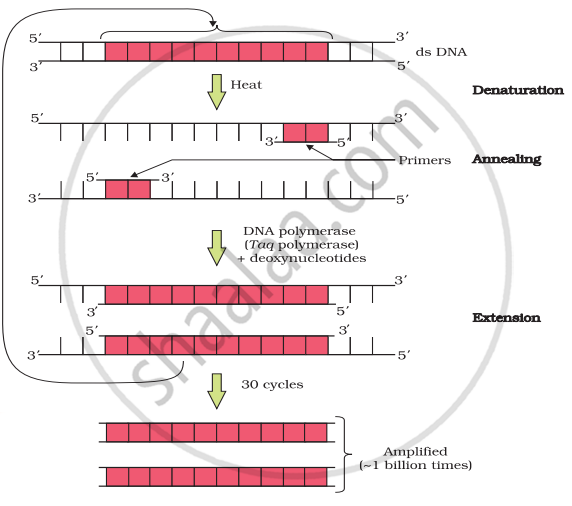Advertisements
Advertisements
Question
Answer the following question:
Describe the process of amplification of the "gene of interest" using the PCR technique.
Solution
To amplify the gene segment of the interest we should know the sequence of the gene of interest. Primers are designed for amplifying the gene of interest. Two sets of primers (chemically synthesized oligonucleotide stretches) that are complementary to the gene of interest, DNA polymerase enzyme, and deoxynucleotides are added. PCR can then be carried out for its amplification.
PCR consists of 3 steps:
- Denaturation - double-helical DNA is denatured by providing high temperature(95-degree Celsius). DNA polymerase does not get degraded in such high temperatures. The DNA polymerase used in this reaction is thermostable and is isolated from the thermophilic bacteria, Thermus aquaticus(Taq).
- Annealing - It is the step in which primers are annealed to single-stranded DNA templates. Two sets of primers are used. The temperature of the reaction mixture is lowered to 50- 65°C for some seconds to allow annealing of primers. DNA polymerase extends the primer in 5' to 3' direction.
- Extension - Replication of DNA occurs in vitro.

- This cycle is repeated several times to generate up to 1 billion identical copies of the DNA.
RELATED QUESTIONS
Name two commonly used bioreactors.
Can you list 10 recombinant proteins which are used in medical practice? Find out where they are used as therapeutics (use the internet).
From what you have learnt, can you tell whether enzymes are bigger or DNA is bigger in molecular size? How did you know?
Explain briefly:
Chitinase
In a pathological lab, a series of steps were undertaken for finding the gene of interest. Describe the steps, or make a flow chart showing the process of amplification of this gene of interest.
DNA fragments generated by the restriction endonuclease in a chemical reaction can be separated by ______.
Identify and explain steps ‘A’, ‘B’ and ‘C’ in the PCR diagram given below.

Illustrate the design of a bioreactor. Highlight the difference between a flask in your laboratory and a bioreactor which allows cells to grow in a continuous culture system.
Read the paragraph given below and answer and questions that follow:
| Enzyme Taq polymerase, is extracted from a eubacterial microorganism Thermus aquaticus from Yellowstone National Park in Montana, USA and isolated by Chien et al. (1976). Taq polymerase successfully replaced the DNA polymerase from E.coli that was being used in PCR earlier and this shift revolutionised the PCR technique. |
- Taq polymerase after its discovery replaced E.coli DNA polymerase in PCR technique. Explain giving reasons why was the need felt for the change?
- What is a primer and its importance in PCR?
- Write the importance of PCR as a diagnostic tool.
Write the scientific name of the source organism of the thermostable DNA polymerase used in PCR.
